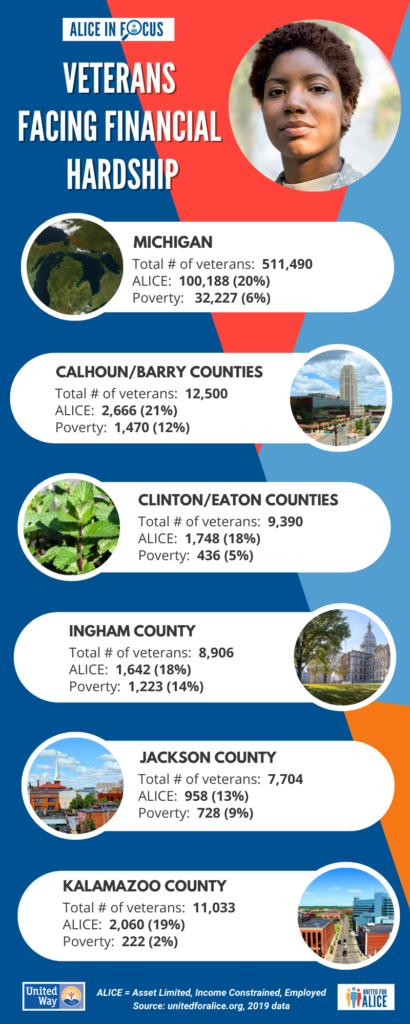
They’ve served and sacrificed for our country, yet more than one of every four veterans in Michigan struggle to afford the basics.
That finding comes from a new report from the Michigan Association of United Ways (MAUW) and its research partner, United For ALICE.
In 2019, 6% of the state’s veterans were deemed in poverty, and 20%—more than three times as many—were ALICE (Asset Limited, Income Constrained, Employed). ALICE households earn more than the Federal Poverty Level but less than what it costs to live and work in the modern economy. Combined, 26% of Michigan’s veterans were below the ALICE Threshold of Financial Survival, with income that doesn’t meet the basic costs of housing, child care, health care, transportation and a smartphone plan.
In UWSCMI’s six-county region, 13,153 veterans live below the ALICE Threshold—27% of 49,533 total veterans. That includes 9,074 who are ALICE and 4,079 living in poverty.
The infographic below outlines the ALICE population by county:

“Our freedom comes with the responsibility to ensure that those who have served and sacrificed don’t struggle to make ends meet once they return home,” said Nancy Lindman, MAUW Director of Public Policy and Partnerships. “Although veterans do have additional supports not afforded nonveterans, clearly there’s still room for improvement.”
The ALICE in Focus: Veterans report and interactive tools reveal that while veterans show lower rates of financial hardship than individuals who never served, Michigan’s veterans face some tougher financial hurdles than their counterparts in Indiana and Ohio.
For example, 33% of Michigan’s veterans earning below the ALICE Threshold spent more than 35% of their income on a mortgage, utilities, tax and insurance. That’s in comparison with 32% in Indiana and 33% in Ohio. And for renters, Michigan had one of the highest rates in the country for struggling veterans being rent burdened at 57%.
In addition, just 16% of Michigan’s financially insecure veterans participated in the Supplemental Nutrition Assistance Program (SNAP), in comparison with 14% in Indiana and 8% in Ohio.
A complete research brief on Michigan veterans is available here.
Lessons from Data
There are some lessons to be learned from the data, said United For ALICE National Director Stephanie Hoopes, Ph.D. The state’s veterans are slightly better off than nonveterans with 26% struggling to make ends meet compared to 30% of adults who never served.
“Veterans have higher rates of full-time employment, are more likely to be homeowners and have more comprehensive health insurance coverage and disability benefits,” Hoopes said. “This suggests that the supports afforded veterans are making a difference and could provide invaluable insights for developing strategies that help nonveterans facing financial hardship.”
Other findings in the state of Michigan from ALICE in Focus: Veterans include:
- Racial and ethnic inequities persist with 41% of American Indian/Alaska Native veterans, 36% of Black veterans and 14% of Hispanic veterans living below the ALICE Threshold compared to 25% of white veterans and 24% of Asian veterans.
- Thirty-two percent of veterans with disabilities struggled more to afford the basics than compared to 23% of veterans without disabilities.
- Inequities also appear for Black veterans with disabilities with 45% living below the ALICE Threshold respectively in comparison with 31% of white veterans with disabilities.
- While working, veterans still experience financial hardship with 13% of veterans with full-time employment living below the ALICE Threshold and 32% of veterans working part time.
- Of veterans who graduated high school but had not completed post-secondary education, 30% were living below the ALICE Threshold.
Consumers Energy Foundation provides funding for the statewide analysis.
More data is available through the ALICE in Focus: Veterans interactive data dashboard, which provides filters for regional and local geographies, age, race, disability status, living arrangements, work status and proximity to military bases. Visit UnitedForALICE.org/Focus-Veterans.
ALICE in Focus: Veterans marks the third installment in the ALICE in Focus Research Series, which draws from the U.S. Census Bureau’s American Community Survey (ACS) Public Use Microdata Samples (PUMS). Each installment in the series highlights a specific segment within the ALICE demographic. The other installments focused on children and people with disabilities.










